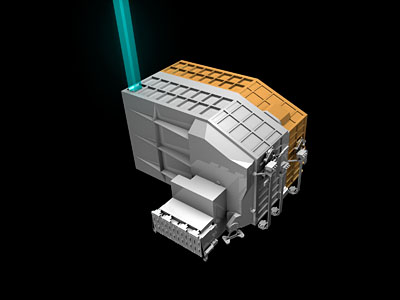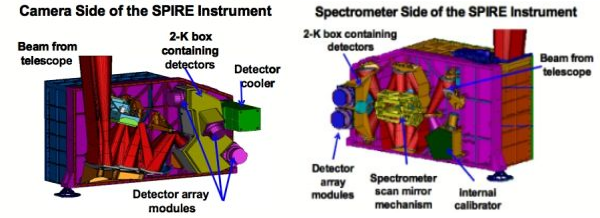The SPIRE Instrument

The SPIRE instrument contained an imaging photometer (camera) and an imaging spectrometer. The camera operated in three wavelength bands centred on 250, 350 and 500 μm, and so made images of the sky simultaneously in three submillimetre “colours”. The spectrometer covered the range 200–670 μm, allowing the spectral features of atoms and molecules to be measured.
The camera and spectrometer occupied separate compartments in the instrument box, as shown in the computer generated image (left). Each instrument compartment contained mirrors, submillimetre filters to define the wavelength bands observed, moveable mirrors to control the beam, internal calibration sources, and detector arrays. The detectors operated at a temperature of 0.3 K, provided by an internal cooler (located on the camera side).
For more information, see the SPIRE page at Cardiff University.

The UK SPIRE Team
The SPIRE project is a large international collaboration. Cardiff University is the lead institute with Professor Matt Griffin as the Principal Investigator. The Consortium includes more than 150 scientists, engineers and managers from eight countries (Canada, China, France, Italy, Spain, Sweden, UK, USA). In the UK, the institutes involved in the design, construction and operation of Herschel SPIRE are:
- Cardiff University
- Imperial College
- MSSL, Surrey
- Rutherford Appleton Laboratory
- UK Astronomy Technology Centre
- University of Sussex
Some institutions using SPIRE for research include University of Nottingham, the Open University and Cambridge University among others. See our ‘Team’ section for further details.
UK funding for Herschel SPIRE has been provided by the Science and Technology Facilities Council (STFC).
International Partners
Our international partners on the SPIRE instrument are from a large number of institutions in France, Spain, Sweden, Italy, US, Beijing and Canada – see here for a list. International funding has been provided by the national agencies of the participating countries and by internal institute funding: the Canadian Space Agency (CSA); NAOC in China; Centre National d’Etudes Spatiales (CNES), Centre National de la Recherche Scientifique (CNRS), and CEA in France; Agenzia Spaziale Italiana (ASI) in Italy; Ministerio de Educacion y Ciencia (MEC) in Spain, Stockholm Observatory in Sweden; the Science and Technology Facilities Council (STFC) in the UK; and NASA in the USA. Additional funding support for some instrument activities has been provided by ESA.
